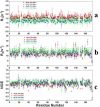Increased hydrophobicity and decreased backbone flexibility explain the lower solubility of a cataract-linked mutant of γD-crystallin
- PMID: 21827768
- PMCID: PMC3184788
- DOI: 10.1016/j.jmb.2011.07.058
Increased hydrophobicity and decreased backbone flexibility explain the lower solubility of a cataract-linked mutant of γD-crystallin
Abstract
A number of point mutations in γD-crystallin are associated with human cataract. The Pro23-to-Thr (P23T) mutation is perhaps the most common, is geographically widespread, and presents itself in a variety of phenotypes. It is therefore important to understand the molecular basis of lens opacity due to this mutation. In our earlier studies, we noted that P23T shows retrograde and sharply lowered solubility, most likely due to the emergence of hydrophobic patches involved in protein aggregation. Binding of 4,4'-dianilino-1,1'-binaphthyl-5,5'-disulfonate (Bis-ANS) dye (a probe commonly used for detecting surface hydrophobicity) competed with aggregation, suggesting that the residues involved in Bis-ANS binding are also involved in protein aggregation. Here, using NMR spectroscopy in conjunction with Bis-ANS binding, we identify three residues (Y16, D21, and Y50) in P23T that are involved in binding the dye. Furthermore, using (15)N NMR relaxation experiments, we show that, in the mutant protein, backbone fluctuations are restricted to the picosecond-to-nanosecond and microsecond timescales relative to the wild type. Our present studies specify the residues involved in these two pivotal characteristics of the mutant protein, namely increased surface hydrophobicity and restricted mobility of the protein backbone, which can explain the nucleation and further propagation of protein aggregates. Thus, we have now identified the residues in the P23T mutant that give rise to novel hydrophobic surfaces, as well as those regions of the protein backbone where fluctuations in different timescales are restricted, providing a comprehensive understanding of how lens opacity could result from this mutation.
Copyright © 2011 Elsevier Ltd. All rights reserved.
Figures








Similar articles
-
Increase in surface hydrophobicity of the cataract-associated P23T mutant of human gammaD-crystallin is responsible for its dramatically lower, retrograde solubility.Biochemistry. 2010 Jul 27;49(29):6122-9. doi: 10.1021/bi100664s. Biochemistry. 2010. PMID: 20553008 Free PMC article.
-
NMR study of the cataract-linked P23T mutant of human gammaD-crystallin shows minor changes in hydrophobic patches that reflect its retrograde solubility.Biochem Biophys Res Commun. 2009 Apr 24;382(1):196-9. doi: 10.1016/j.bbrc.2009.03.007. Epub 2009 Mar 9. Biochem Biophys Res Commun. 2009. PMID: 19275895 Free PMC article.
-
Decrease in protein solubility and cataract formation caused by the Pro23 to Thr mutation in human gamma D-crystallin.Biochemistry. 2005 Feb 22;44(7):2491-500. doi: 10.1021/bi0479611. Biochemistry. 2005. PMID: 15709761
-
The P23T cataract mutation causes loss of solubility of folded gammaD-crystallin.J Mol Biol. 2004 Oct 15;343(2):435-44. doi: 10.1016/j.jmb.2004.08.050. J Mol Biol. 2004. PMID: 15451671
-
The cataract-associated V41M mutant of human γS-crystallin shows specific structural changes that directly enhance local surface hydrophobicity.Biochem Biophys Res Commun. 2014 Jan 3;443(1):110-4. doi: 10.1016/j.bbrc.2013.11.073. Epub 2013 Nov 25. Biochem Biophys Res Commun. 2014. PMID: 24287181 Free PMC article.
Cited by
-
Mutation screening of crystallin genes in Chinese families with congenital cataracts.Mol Vis. 2019 Aug 9;25:427-437. eCollection 2019. Mol Vis. 2019. PMID: 31523120 Free PMC article.
-
Human αB-crystallin discriminates between aggregation-prone and function-preserving variants of a client protein.Biochim Biophys Acta Gen Subj. 2020 Mar;1864(3):129502. doi: 10.1016/j.bbagen.2019.129502. Epub 2019 Dec 5. Biochim Biophys Acta Gen Subj. 2020. PMID: 31812542 Free PMC article.
-
Increased hydrophobicity of CRYGD p.(Ala159ProfsTer9): Suspected cause of congenital cataracts in a large Chinese family.Mol Genet Genomic Med. 2020 Oct;8(10):e1436. doi: 10.1002/mgg3.1436. Epub 2020 Jul 23. Mol Genet Genomic Med. 2020. PMID: 33460241 Free PMC article.
-
Temperature-Dependent Interactions Explain Normal and Inverted Solubility in a γD-Crystallin Mutant.Biophys J. 2019 Sep 3;117(5):930-937. doi: 10.1016/j.bpj.2019.07.019. Epub 2019 Jul 19. Biophys J. 2019. PMID: 31422822 Free PMC article.
-
Trafficking-deficient mutant GABRG2 subunit amount may modify epilepsy phenotype.Ann Neurol. 2013 Oct;74(4):547-59. doi: 10.1002/ana.23947. Epub 2013 Sep 16. Ann Neurol. 2013. PMID: 23720301 Free PMC article.
References
-
- Zetterstrom C, Lundvall A, Kugelberg M. Cataracts in children. J Cataract Refract Surg. 2005;31:824–40. - PubMed
-
- Hammond CJ, Snieder H, Spector TD, Gilbert CE. Genetic and environmental factors in age-related nuclear cataracts in monozygotic and dizygotic twins. N Engl J Med. 2000;342:1786–90. - PubMed
-
- Pande A, Annunziata O, Asherie N, Ogun O, Benedek GB, Pande J. Decrease in protein solubility and cataract formation caused by the Pro23 to Thr mutation in human gamma D-crystallin. Biochemistry. 2005;44:2491–500. - PubMed
Publication types
MeSH terms
Substances
Grants and funding
LinkOut - more resources
Full Text Sources
Medical
Miscellaneous

